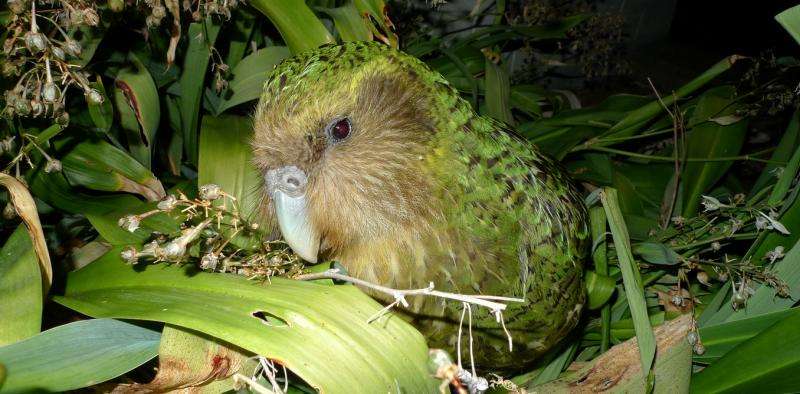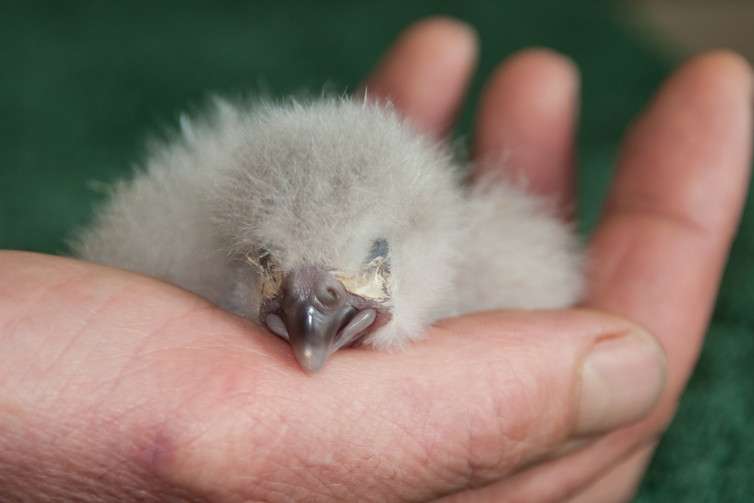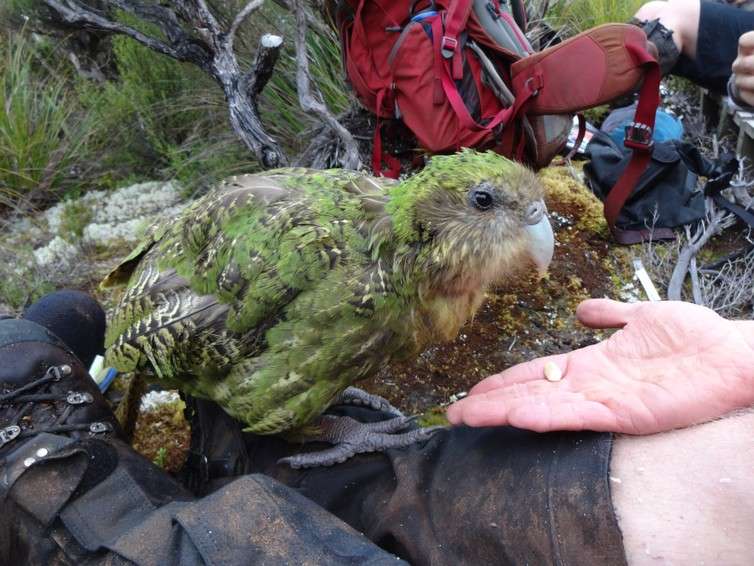Plant hormone boost for New Zealand's critically endangered night parrot

New Zealand's nocturnal and flightless parrot, the kākāpō, may be famous for trying to mate with the head of biologist Mark Carwardine, but this unique species is facing some serious challenges.
With fewer than 160 birds alive, kākāpō are critically endangered. One reason for their dwindling numbers is that they only breed every few years, when native trees produce masses of edible fruit or seeds.
Our research suggests that the birds' breeding success depends on oestrogen-like hormones (phytoestrogens) found in these native plants.
Hormone boost from plants
Our study included kākāpō (Strigops habroptilus) and two other New Zealand native parrots, the endangered kākā (Nestor meridionalis) and kea (Nestor notabilis). All three have infrequent breeding success.
Kākāpō in particular have a low reproductive rate and together with the kākā, only breed successfully every three or four years, during mast years, when mass fruiting of native trees occurs.
2016 was a mast year and a record breeding season for kākāpō - the best since New Zealand's Department of Conservation began managing and monitoring the night parrots 25 years ago.
This link between the parrots' successful breeding and high levels of fruiting in native plants has focused our investigations on potential stimulants present in their food plants that might activate or improve reproduction.
One hypothesis is that steroid-like compounds in the fruits of certain native plants provide a trigger for breeding. It proposes that kākāpō don't produce enough of the hormone oestrogen to make a fertile egg, but by eating these fruits and the phytoestrogens they contain, the birds supplement their own hormone levels.
This increases the production of egg yolk protein, which in turn leads to eggs that have a better chance of being fertilised successfully.
We know from other studies that kākāpō seek out the fruit from the native rimu tree (Dacrycarpus cupressinum) during mast years. We believe that this is how kākāpō get extra oestrogen from their diet, and that rimu and other native plants provide a hormone boost that is key to kākāpō reproduction.
Parrots more sensitive to oestrogen
In our current study, conducted by PhD graduate Dr Catherine Davis, we examined the receptivity of New Zealand and Australian parrots to a range of steroid compounds, including oestrogens, and compared it to those of other birds.
We tested various native plant species for oestrogenic content and we found that indeed there is a high amount of phytoestrogens in some of New Zealand's native plants.

We then looked at the receptivity of parrots to this plant hormone. We studied the genetic makeup of the receptor that is activated by oestrogens in kākāpō, kea, kākā, kākāriki, the Australian cockatiel, and compared this with those in the chicken.
We found that the parrots' oestrogen receptor was different. All of the parrot species have a unique sequence in the receptor gene, which may make them more sensitive to oestrogen, compared to other bird species, or humans.
In parrots, this receptor contains an extra eight amino acids in the region that binds the hormone.
Increasing fertility
By adding this amino acid sequence to a computer modelling programme based on the human oestrogen receptor, we have shown that this difference in the parrot-specific receptor would change the strength with which it binds to the oestrogen hormone.
The down-stream effects of this may be an increased sensitivity to plant oestrogens in parrots. This research supports the notion that the parrots' oestrogen receptor responds differently to oestrogenic compounds in native trees in New Zealand during mast years.

We have previously confirmed the presence of oestrogenic activity in key compounds present in rimu and tōtara (Podocarpus totara), as well as extracts from a number of New Zealand plant species that kākāpō are known to graze. However, the chemical structures of the oestrogenic materials of most New Zealand native plants are not known.
The question remains why the rate of successful breeding of kākāpō in mast years is lower than that of other parrot species. The identification of plant chemicals capable of binding to the parrot oestrogen receptor together with information about plant grazing behaviours of parrots may provide new insights into the conservation of the species that are in decline.
With further research, we are hoping to identify the specific compound in native plants that elicits these oestrogenic properties. This information may enable us to synthesise this compound in the lab. It could then be administered in some way to increase the fertility of our native parrots.
Provided by The Conversation
This article was originally published on The Conversation. Read the original article.![]()



















